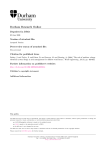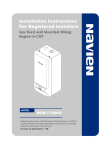Download Installation and Operating Instructions
Transcript
Installation and Operating Instructions Amber Switch Type CAS-I-B 1 Introduction 2 Amber Switch is an automatic, electronic, frequency-sensing, operating control. It can be applied to small islanded power systems with renewable generation which produce a variable frequency, some inverters for example. Amber Switch can switch on additional loads for surplus renewable generation which might otherwise be wasted. Amber Switch determines this surplus generation by detecting a rise in the system frequency. This may be caused by low load on a generator with frequency droop, or an increase in frequency from battery inverters to signal a high state of battery charge. Amber Switch incorporates a number of features to help ensure stable operation of an islanded power system: • • • • A range of switch-on setting frequencies are available to create a prioritised system The switch-off frequency is lower than the switch-on frequency to avoid constant switching and provide stability. When the frequency goes above the switch-on setting there is a delay before the load is connected, with a higher frequency causing a shorter delay. A similar delay applies at switch-off for low frequencies The delays are randomised to avoid multiple devices switching simultaneously. Each time the Amber Switch operates, a new random time factor is chosen, to help ensure fairness across the entire power system. Amber Switch can control loads up to 15A (3.4kW at 230V; 1.8kW at 120V). The most appropriate loads are heaters (water heaters, storage heaters, space heaters). Appliances with pumps are not appropriate due to the potential for frequent switching of loads. There are 8 selectable frequencies for the 50Hz band and 8 for the 60Hz band. For a small number of loads with equal priority, the default setting of 51Hz may be used. For systems with many loads, different priorities may need to be set by the system manager. For instance it might be decided that immersion heaters are given highest priority (lowest frequency), then portable space heaters and finally fixed space heaters (highest frequency). Description of Operation Amber Switch is a completely autonomous device which requires no user intervention. It will switch the load on when the system frequency is high and switch it off when the frequency is low, as described in the Introduction. Indications Two LEDs indicate the operating state of the device, see Table 1. Faster flashing of the amber LED indicates a shorter time to switch, slower flashing indicates that it will take longer to switch on. Loss of Supply As would be expected, any appliance or load fed through the Amber Switch will switch off when the supply is lost. When the supply is restored the appliance may operate for a few seconds while the Amber Switch powers up. At that point the appliance will be switched off while the Amber Switch assesses the supply frequency. If the frequency is above the switch-on setting the normal switch-on delay will apply and then the appliance will be switched on. 3 Settings Only one user-adjustable setting is provided (switch-on frequency) and this is only accessible during installation (see section 4). Under normal circumstances it should not be necessary to adjust the setting once it has been set during installation. The setting is achieved through a DIP switch (see Figure 2). Table 2 shows the positions for each frequency setting. In the Figure 2 example all the switches are OFF (down), representing a setting of 61.5 Hz. DO NOT REMOVE THE COVER OR ADJUST SETTINGS UNLESS THE AMBER SWITCH IS ISOLATED FROM THE POWER SUPPLY. Figure 2 Setting DIPSwitch Figure 1 Schematic Arrangement of Amber Switch Lin Lout N N E E Table 2 Frequency Settings LOAD SUPPLY f> Setting Table 1 LED states 1 2 3 4 49.75Hz ON ON ON ON 50.0 ON ON ON OFF 50.25 ON Setting 1 2 59.75Hz OFF ON 3 4 ON ON 60.0 OFF ON ON OFF ON OFF ON 60.25 OFF ON OFF ON ON OFF OFF 60.5 OFF ON OFF OFF 60.75 OFF OFF ON LED state System state Load 50.5 ON Amber LED steady Frequency low Off 50.75 ON OFF ON Amber LED flashing Frequency high, delay in progress Off 51.0 ON OFF ON OFF 61.0 OFF OFF ON OFF Green LED steady Frequency high On 51.25 ON OFF OFF ON 61.25 OFF OFF OFF ON Both LEDs off Supply to Amber Switch is off Off 51.5 ON OFF OFF OFF 61.5 OFF OFF OFF OFF ON Amber Control Limited. Company No. 08381101. Registered office: 4 Butt Bank, Fourstones, Hexham. NE47 5DN. ON Installation and Operating Instructions for Amber Switch Amber Switch Type CAS-I-B 4 Installation inside the base and tighten the gland to secure the cord. Strip back the sheath by 25mm and remove 5mm of insulation from each wire. Repeat this for the supply cord (b). Amber Switch should be installed by a competent person. If in doubt consult a qualified electrician and always adhere to local regulations. 5. Connect the supply cord (b) to the supply terminals (Lin, N and E) and the load cord to the load terminals (Lout, N and E) (Figure 4). Ensure the Live, Neutral and Earth/Ground wires are connected to the correct terminals (Table 3). 6. With the aid of a small screwdriver set the frequency setting using the DIP switch (Figure 2), referring to Table 2. The allocation of frequencies to loads should be planned before deploying the load controllers to help ensure stable system operation. Contact your distributor for further advice. 7. Fit the cover ensuring that all the screws are tight. 8. Reconnect the supply circuit. 5 Maintenance DO NOT REMOVE THE COVER UNLESS THE AMBER SWITCH IS ISOLATED FROM THE POWER SUPPLY. Amber Switch should be independently surface-mounted, and connected to a circuit fitted with a fuse or MCB with rating 15A or less, using flexible cords (Figure 3). Amber Switch may be used with a fixed appliance, or a socket which enables portable appliances to be plugged in. The term “controlled load” is used to describe both of these options. Follow any installation instructions for the controlled load, and any local regulations. Ensure that the supply and load cords (b and d in Figure 3) are appropriate for the protection rating of the circuit. 1. 2. If the controlled load is pre-existing, isolate the circuit which supplies it and disconnect the supply cord from the fused spur or cord outlet (a in Figure 3). This will become the load cord (d). If the controlled load is new, ensure there is a suitable fused spur or flexible cord outlet to supply the load, and that it is isolated from the supply. Install the controlled load (e), with the load cord (d), following any manufacturer’s instructions. 3. Remove the cover from the Amber Switch and mount the base on the wall (c) adjacent to the controlled load (e). 4. Fit the load cord (d) from the controlled load through a gland in the Amber Switch base. Ensure that 120mm of cord protrudes Figure 3 Connection of Amber Switch Fused Spur or cord outlet (a) The Amber Switch is completely maintenance-free with no user serviceable parts. The Amber Switch should be inspected for damage or deterioration every 24 months. 6 Specification This specification is declared in accordance with the definitions of BS EN 60730-1:2000. Regulatory Compliance LV Directive EMC Directive RoHS Directive 2006/95/EC 2004/108/EC 2011/65/EU A CE mark is affixed to the Amber Switch indicating conformity with the above directives. Amber Switch (c) E E Lin Lout N N Controlled Load (e) Supply cord (b) Load cord (d) Figure 4 Connection Terminals Electrical Limits Supply voltage Supply frequency f Maximum load Imax Rated impulse voltage Environmental Conditions IP Rating Ambient temperature No. of cycles Aging Type of load Mounting 205 – 45 – fon Table 3 Terminal Connections Terminal identifier Supply Load Live Neutral Earth / Ground Lin N E Lout N E Brown Blue Green/Yellow Switch-off frequency Switch-on time Switch-off time Automatic action Software class Wire colour (Europe) Page 2 of 2 foff ton toff VAC Hz A kV IP20 0– 30 ºC 300,000 60,000 hrs substantially resistive pf ≥0.95 Independent surface mounting Electrical connections Cable glands cable diameter Stranded cable all terminals Characteristics Switch-on frequency 255 65 15 1.5 6– 0.2 – 30 – 10 mm 2 2.5 mm 12 AWG 49.75 to 51.5, 59.75 to 61.5 Hz in 0.25 Hz steps < fon - 0.25 Hz < 14 / (f - fon) s < 14 / (foff - f) s Type 1.C (micro-interruption) Class A 62111-C01-U001 v0.4a draft 01










